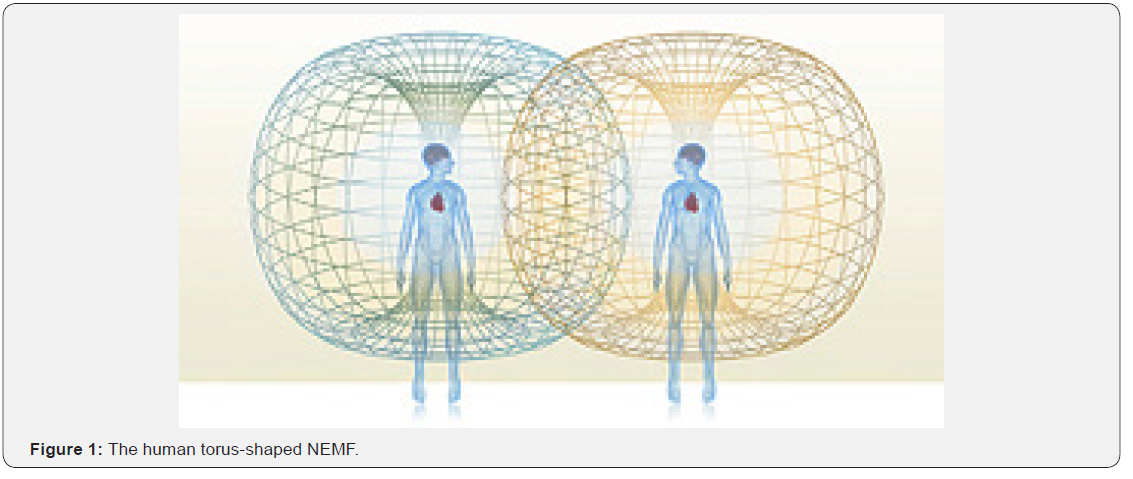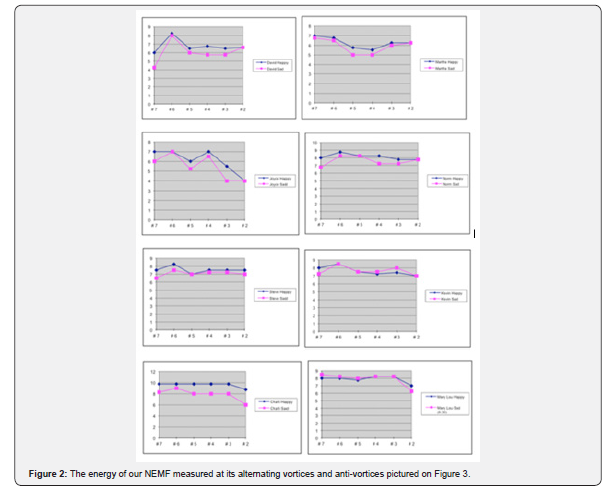Our Weak Nonlinear Electromagnetic Field (Nemf) that Rules Everything in the Body is Emotionally Sensitive- juniper Publishers
Juniper Publishers- Journal of Complementary medicine
Abstract
The Russian scientist Shkatov used his patented
equipment ‘torsemeter’ to measure the direction of spinning of our weak
NEMF. He found that negative emotions make the torus-shaped NEMF spin
faster counterclockwise, while positive emotions make it spin clockwise.
In this article, the finding of the Russian scientist Shkatov was
compared with measurements with our patented equipment of the energy of
the alternating vortices and anti-vortices of our NEMF at positive and
negative emotion (or just positive or negative thinking). This
comparison (with the help of nonlinear physics) allowed us to see the
whole dynamics of our weak NEMF, which rules and regulates everything in
the body. This helped us see the role emotions play in our health and
in the onset of chronic diseases or cancer.
Keywords: Human nonlinear
EMF; EMF spinning at negative emotions; EMF spinning at positive
emotions; Our measurements of the nonlinear EMF; Revealing the dynamics
of our EMFIntroduction
Imagine listening to a harmonious classical music.
The music is harmonious and pleases your ears because the symphony
orchestra has a conductor, who synchronizes the sounds of all musical
instruments in his orchestra. This is exactly what the weak nonlinear
electromagnetic field does in the body - it synchronizes the work of all
cells in the body. When the cells work in perfect harmony, we enjoy
perfect health. When one of the organs starts functioning out of synch,
we cannot enjoy our health and our life any more. We suffer pain of this
organ, and pain is the cry of the body for help.
What did cause the ‘false sounding’ of the organ that
became sick? The answer is - stress. How stress does this? The stress
causes delay because the body needs to stop what it was doing at the
moment and mobilize for response to the stressor - to fight or flight,
adapt or resist. Especially damaging is strong or prolonged stress,
which is a chain of stressors acting through small intervals of time.
The delays they create accumulate and the body cannot compensate for the
large delays they create [1].
For periodic reactions, the delays are called phase
shifts. The phase shifts, caused by the stress-induced delays, are the
ones that desynchronize the harmonic work of the cells. They move along
the chain of organs following the energy cycle of organs’ activity [2]
until the genetically weak organ, which does not have enough energy to
propel them, absorbs them. This makes the functioning
of the genetically weak organ even more sluggish, which manifests in
pain of this organ. We call it chronic disease [1].
This simple explanation is in full agreement with the
findings of Selye [3,4] who spent 40 years of his life studding stress
and who was the first to use the name psychological stress. He borrowed
the word stress from engineering and he explained that just as stress
applied to a material cracks it at the weakest place, strong or
prolonged psychological stress “cracks” the body at the weakest place -
the genetically inherited weak organ of the body. In this way, he
explained his finding that the same stress causes different chronic
diseases (or cancer) in different individuals.
Now, let’s go back to where we started. Since our
weak NEMF synchronizes the work of all cells in the body and stress is
the one that desynchronizes them through the phase shifts it causes, we
should be able to cure the induced-by-stress diseases (chronic diseases
or cancer - it depends on genetic predisposition) with restoring the
normal NEMF, which has been distorted by the stress. This is in full
agreement with what we said in our previous article: Physics not
Chemistry Is Going to Solve the Cancer Problem [5].
The Direction of Spinning of our NEMF is Ruled by Emotions. When Combined with our Measurements it Gives the Whole Dynamics of our NEMF
When we say stress, we mean negative stress, which is
also called distress. What happens to our torus-shaped NEMF (Figure 1)
when we experience distress? The Russian scientist Shkatov
developed and patented equipment, called ‘torsemeter’, which
allows him to measure the spinning of our NEMF. He found that
at negative emotions (distress) the torus-shaped NEMF spins
counterclockwise [6].

We measured the weak NEMF with our patented supersensitive
energy meter and we found that at negative emotions (or just
negative thinking) the NEMF looses energy (Figure 2). Not only is
the total energy of the NEMF lower, it is more imbalanced because
the genetically weak organ drops in energy maximum. This means
that each distress takes us a step farther to a chronic disease or
cancer of the genetically inherited weak organ [7].

But is there something that we can do to prevent the chronic
disease or cancer? Measurements of Shkatov revealed that at
positive emotions the torus-shaped NEMF spins clockwise [6].
Our measurements of NEMF revealed that at positive emotions
(or just positive thinking) the energy of the NEMF increases and
becomes more balanced (Figure 2). This means that each positive
emotion (or just positive thought) is making you healthier [7].
Perfectly balanced NEMF is the healthiest.
Nonlinear Physics needs to step in to explain why the things
are the way we found them. There is a rule of the folded fingers of
the right hand, which states that if the folded fingers are curved
in direction of the electric currents, the thumb would show the
direction of the magnetic field induced by the currents. Let us
apply this to our spinning NEMF.
At negative emotions (or just negative thinking), the counterclockwise
spinning of our NEMF will induce counterclockwise currents.
Let’s orient the fingers of our right hand counterclockwise,
then the thumb would show direction outward for the magnetic
field, which means our NEMF will be loosing magnetic energy at
negative emotions (or just negative thinking) [6].
At positive emotions (or just positive thinking), the clockwise
spinning of our NEMF will induce clockwise currents. Let’s orient
the fingers of our right hand clockwise, and then the thumb would
show direction inward for the magnetic field, which means our
NEMF will be gaining magnetic energy at positive emotions (or
just positive thinking) [7] (Figure 3).

However, the wise ancient Chinese men used to say [8]: avoid
pursuing big goals in life, but if you fail in pursuing your goal, you
need to have 3 to 4 smaller goals the successful achievement of
which will compensate for your failure in pursuing the first goal.
This means that if we have problem balancing our emotions, it is
because we need three to four positive emotions to compensate
for one negative emotion.
Interestingly, contemporary studies of stress found the same
ratio. When comparing the biochemical substances released
at negative emotion (distress) with the amount of biochemical
substances released at positive emotions, the scientist found the
same ratio 1: 3-4 [9].
Conclusion
Now, let’s go back to the spinning of our NEMF. If 3 to 4 positive
emotions are necessary to compensate for one negative emotion,
this means that at negative emotions (when the torus-shaped
NEMF spins counterclockwise), it must spin 3 to 4 time faster. Only
then would the lost energy at negative emotions be compensated
by 3 to 4 positive emotions.
The large amount of energy lost at negative emotions
explains
the ancient wisdom of the Hindus “do everything to avoid anger
because anger is a very destructive emotion. Always remember
that ‘Anger’ is only one letter away from ‘Danger’” [6]. The advice of
the ancient Hindus was: Only the dumb people become angry.
The smart people know that they need to stop the oncoming anger
as soon as they notice that they are getting irritated.




Comments
Post a Comment